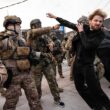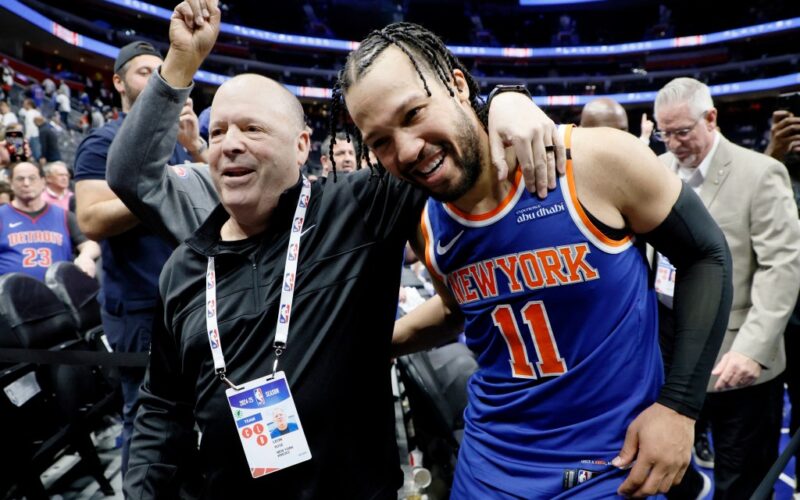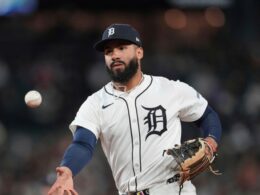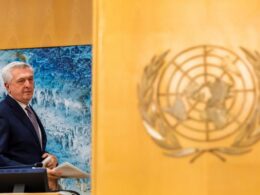Five years ago, Leon Rose walked into Madison Square Garden with no front-office experience and a mountain of skepticism. Today, he oversees a roster loaded with All-Stars, Olympic gold medalists, and Villanova champions — the result of one of the most aggressive, calculated rebuilds in modern Knicks history.
The Knicks enter the 2025–26 season with the second-best odds to emerge from a battered Eastern Conference and reach the NBA Finals for the first time in more than a quarter-century. Every move since the day Rose took the reins as president of basketball operations has built toward this moment — a season that could define his tenure and rewrite the franchise’s modern legacy.
From the moment Rose took over in 2020, every decision — from hiring Tom Thibodeau to acquiring Jalen Brunson, OG Anunoby, Karl-Anthony Towns and Mikal Bridges — has been part of a deliberate climb.
Rose’s Knicks aren’t here by chance. Brick by brick, deal by deal, a perennial rebuild became a legitimate championship pursuit.
Here’s how the transformation unfolded — five years, a handful of signature moves, and a singular focus to deliver New York City its first title in more than 50 years.
2020 — THE FOUNDATION: HIRING THIBODEAU
Six coaches in seven years. No identity. A restless fan base desperate for stability.
Rose’s first move was cultural, not cosmetic — hiring Thibodeau, the defensive disciplinarian and former Knicks assistant known for structure and accountability.
Thibodeau delivered immediately. Julius Randle blossomed into an All-NBA forward, winning Most Improved Player as the Knicks went 41–31 and snapped their eight-year playoff drought. Thibodeau earned his second Coach of the Year award and reignited the Garden’s pulse.
Across five seasons, he restored credibility to a dormant franchise — posting a 226–174 record, authoring back-to-back 50-win campaigns, and leading New York to its first conference finals since 2000.
2022 — THE TURNING POINT: MOVING WALKER, SIGNING BRUNSON
Kemba Walker arrived in New York three years too late. Once an elite scorer, he battled injuries and inconsistency, forcing the Knicks to trade his contract — and surrender draft capital — to clear cap space.
That sacrifice paved the way for a franchise-altering signing: Brunson, four years, $104 million.
Critics called it an overpay. A season later, Brunson was an All-Star, All-NBA guard, and Clutch Player of the Year. He gave the Knicks something they’d lacked for decades — a steady hand, a fearless leader, and a true floor general.
A move once questioned for its price has since become one of the greatest bargains in franchise history.
2023 — THE SPARK: TRADING FOR HART
Cam Reddish never earned Thibodeau’s trust. The Knicks needed reliability — and found it in Josh Hart.
Rose packaged Reddish, Ryan Arcidiacono, Svi Mykhailiuk, and a protected first-round pick to Portland for the relentless Villanova guard. The timing was perfect: New York hovered around .500 and needed a spark.
Hart delivered instantly. His energy, rebounding, and chemistry with Brunson fueled a 17–8 finish and a playoff run that saw him make every hustle play imaginable in the first-round win over Cleveland.
The Knicks rewarded him with a four-year, $81 million extension. Hart wasn’t the star of Rose’s rebuild — he was its soul.
2024 — THE REFIT: TRADING FOR ANUNOBY
By 2024, the Knicks had talent — but not balance.
RJ Barrett and Immanuel Quickley were gifted scorers, but their fit alongside Brunson and Randle was clunky. The front office sought a two-way wing who could defend elite scorers and space the floor.
On Dec. 30, 2023, the Knicks sent Barrett, Quickley, and a prized second-rounder to Toronto for Anunoby, Precious Achiuwa, and Malachi Flynn. The transformation was immediate: New York went 20–3 in Anunoby’s first 23 games, morphing into one of the NBA’s toughest defensive teams.
That summer, the Knicks made it official — re-signing Anunoby to a five-year, $212.5 million extension, the richest contract in team history.
2024 — THE POWER SHIFT: BRIDGES AND TOWNS ARRIVE
Maybe it was inevitable that Bridges would end up in New York — the Villanova reunion always felt written in the stars. But the sequence that brought Towns to Madison Square Garden was anything but simple.
Isaiah Hartenstein’s decision to decline the Knicks’ maximum offer and sign a three-year, $89 million deal with the Oklahoma City Thunder forced Rose’s hand. Had Hartenstein stayed, New York could have used Bird Rights to exceed the cap and retain him. Without that option — and with Mitchell Robinson’s ankle injuries creating uncertainty at center — the Knicks needed a solution.
They made a bold one.
Rose sent Randle, Donte DiVincenzo, and a first-round pick to Minnesota for Towns — first landing Brunson’s former college teammate, next one of the most skilled big men in the league.
Towns became an All-Star starter in his first season at The Garden and helped lead New York to its first Eastern Conference Finals appearance in 25 years.
Rose doubled down on a vision — and mortgaged much of the Knicks’ future to realize it.
The trades for Bridges and Towns vaulted New York into legitimate title contention, but at a staggering cost. The five first-rounders surrendered to the Nets all but emptied the Knicks’ draft chest, leaving little flexibility to chase future stars. Towns’ $50-million-plus annual salary pushed New York to the brink of the second apron, effectively freezing their ability to meaningfully retool the roster.
This was the price of doing business — the cost of contention in the modern NBA. Rose paid it willingly. The bet is that chemistry, health, and timing can deliver what decades of patience could not.
2025 — THE PIVOT: FROM THIBODEAU TO BROWN
It was a bittersweet ending for a coach who brought the Knicks back to relevance. Thibodeau led New York to its first Eastern Conference Finals this century — then was shown the door.
The decision was equal parts emotional and evolutionary.
As successful as Thibodeau’s Knicks had been, it became clear that the same formula that restored credibility had also created a ceiling. Every grinding possession, every 40-minute workload, every tight rotation revealed the limits of a system built on effort and endurance more than fluidity and freedom.
Rose and his front office believed it was time for a new voice — and a new vision.
Enter Mike Brown.
Brown’s arrival signaled the next phase of the rebuild: from grit to growth, from discipline to dynamism. In Tarrytown, he’s already implemented a collaborative approach — empowering assistants, emphasizing pace, spacing, quick decisions, and relentless ball movement.
The goal is clear: transform what was once a grind into a glide.
The firing and hiring is one of Rose’s biggest gambles yet. But he’s earned the right to push his chips to the center of the table — because every calculated risk he’s made has brought the Knicks closer to where they’ve always believed they belong.
Originally Published:








